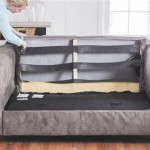How To Fix A Torn Faux Leather Sofa
Faux leather, also known as pleather or vegan leather, is a popular upholstery material due to its affordability and resemblance to genuine leather. However, like any material, it’s susceptible to wear and tear, including tears. Repairing a torn faux leather sofa is a manageable task, potentially saving the cost of reupholstering or replacing the entire piece of furniture. The following guide provides detailed instructions on how to address various types of tears in faux leather, ensuring a lasting and aesthetically pleasing repair.
Assessing the Damage
Before initiating any repair, a thorough assessment of the damage is crucial. The type and size of the tear will dictate the appropriate repair method and materials needed. Small tears, less than half an inch, can often be mended with simple adhesive techniques. Larger tears, rips along seams, or areas with significant material loss require more extensive patching and reinforcement.
Examine the condition of the surrounding faux leather. Is it dry and brittle, or still relatively pliable? Brittle material is more likely to crack or tear further during repair. The condition will influence the choice of adhesives and patching materials. Note the original color and texture of the faux leather, as matching these characteristics is essential for a seamless repair.
Determine the cause of the tear. Is it due to sharp objects, excessive stretching, or general wear and tear? Addressing the underlying cause can prevent future damage. Consider using protectors to shield the sofa from sharp objects, avoid jumping or placing excessive weight on specific areas, and regularly condition the faux leather to maintain its pliability.
Materials and Tools Required
Successful faux leather repair necessitates the right tools and materials. A comprehensive list includes:
*Faux Leather Repair Kit:
These kits typically contain a color-matching compound, applicator tools, and sometimes grain paper to replicate the original texture. These are readily available online and at most hardware stores. *Leather Glue or Contact Cement:
Specifically formulated for leather or vinyl, these adhesives provide a strong and flexible bond. *Patching Material:
A piece of faux leather that closely matches the color, texture, and thickness of the sofa's existing material. This can often be sourced from a hidden area of the sofa, such as underneath the cushions or along the back. *Sharp Scissors or a Utility Knife:
For precisely cutting the patching material. *Tweezers:
For manipulating small pieces of material and aligning edges. *Sanding Block or Fine-Grit Sandpaper:
Used to smooth rough edges around the tear. *Cleaning Solution:
A mild soap and water solution to clean the area around the tear. Isopropyl alcohol can also be used, but test it in an inconspicuous area first to ensure it doesn't damage the faux leather. *Clean Rags or Microfiber Cloths:
For applying cleaning solutions and wiping away excess adhesive. *Heat Gun or Hair Dryer (Optional):
For accelerating the drying process of some adhesives. *Sewing Needle and Thread (Optional):
For reinforcing seams and edges, particularly with larger tears. The thread should match the color of the existing stitching. *Seam Ripper (Optional):
For carefully removing existing stitching around a seam tear. *Grain Paper (Optional):
If the repair kit doesn't include it, grain paper can be used to imprint the texture of the faux leather onto the repair compound.Step-by-Step Repair Process
The following outlines the steps involved in repairing a torn faux leather sofa. Specific instructions might vary slightly depending on the severity and location of the tear.
1.
Preparation:
Begin by thoroughly cleaning the area surrounding the tear with a mild soap and water solution. Gently scrub away any dirt, debris, or oils. Allow the area to dry completely. If the edges of the tear are frayed or uneven, carefully trim them with sharp scissors or a utility knife to create a clean edge. Avoid removing too much material, as this will make the tear larger.2.
Edge Alignment:
Using tweezers, carefully align the edges of the tear as closely as possible. If there is significant material loss, skip this step and proceed directly to patching. For small tears, applying a small amount of leather glue or contact cement to the edges can help hold them in place while the adhesive dries. Apply the adhesive sparingly to prevent excess glue from seeping onto the surface of the faux leather.3.
Patching (If Necessary):
If there is material loss or the tear is large, a patch will be required. Cut a piece of faux leather slightly larger than the tear, ensuring it completely covers the damaged area with some overlap. Thinning the edges of the patch can help it blend seamlessly with the existing material. This can be achieved by carefully skiving the edges with a utility knife or sanding them down with fine-grit sandpaper.4.
Adhesive Application:
Apply leather glue or contact cement to the back of the patch and to the edges of the tear on the sofa. Follow the manufacturer's instructions for the specific adhesive being used. Some contact cements require allowing the adhesive to partially dry before joining the surfaces. Position the patch carefully over the tear, ensuring it is aligned correctly and covers the entire damaged area. Press firmly and hold in place for the recommended time, usually several minutes.5.
Color Matching and Application (If Using Repair Kit):
If using a faux leather repair kit, carefully mix the color-matching compound according to the kit's instructions. Apply the compound in thin layers to the patched area, allowing each layer to dry completely before applying the next. Use the applicator tools provided in the kit to blend the compound with the surrounding faux leather. Avoid applying too much compound at once, as this can result in an uneven or unnatural appearance.6.
Texturing (If Necessary):
If the repair kit includes grain paper, use it to imprint the texture of the faux leather onto the repair compound while it is still slightly wet. Press the grain paper firmly onto the compound and hold it in place for the recommended time. If grain paper is not available, consider using a textured sponge or cloth to create a similar effect. Experiment on a scrap piece of faux leather first to perfect the technique.7.
Seam Repair (If Applicable):
For tears along seams, carefully remove any existing stitching around the tear using a seam ripper. Align the edges of the faux leather and pin them together to hold them in place. Using a sewing needle and thread that matches the color of the existing stitching, sew the seam back together using a similar stitch pattern. Reinforce the seam by backstitching at the beginning and end of the seam.8.
Drying and Curing:
Allow the adhesive or repair compound to dry and cure completely according to the manufacturer's instructions. This may take several hours or even overnight. A heat gun or hair dryer can be used to accelerate the drying process, but be careful not to overheat the faux leather, as this could damage it.9.
Finishing Touches:
Once the repair is dry, inspect it carefully. If there are any rough edges or uneven areas, gently sand them down with fine-grit sandpaper. Apply a thin layer of leather conditioner to the repaired area to help blend it with the surrounding faux leather and restore its pliability. Wipe away any excess conditioner with a clean cloth.
Fix A Rip In Your Leather Sofa Design Inkarnation Art And The Human Condition

Repairing Torn Leather A Quick And Dirty Guide Drsofa Com Blog

Repairing A Ripped Seam In Leather Couch Hometalk

Hide Your Couch S Wear And Tear With These 9 Ingenious Ideas Hometalk

Save Your Sofa Here S How To Repair A Tear In Leather Couch Hometalk

How To Fix Bonded Leather Ling Von Baer

Leather Repair Trick For Small Tears S

Fix Ripped Vinyl Or Leather Diy

How To Fix Ling Leather All About Bonded Faux Couch Repair Chair

How Do I Repair A Small Rip In My Leather Couch Seat Hometalk








